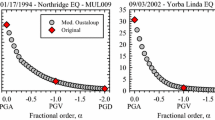Abstract
This paper investigates issues related to the number of ground-motion records required for the performance of site response analysis and the inclusion of the site-specific amplification function within probabilistic seismic hazard calculations (PSHA). It explores the minimum number of records required for a robust estimation of the median and standard deviation of the site amplification function, as well as the impact of the selected ground-motion suites on the results of PSHA. Site response analyses are performed using both equivalent linear and nonlinear methodologies. Although the median amplification was observed to be relatively easy to capture, the standard deviation was seen to fluctuate considerably, especially when suites of few records were used. It was observed that in the case of the nonlinear site response analysis 10 records provide relatively stable estimates of the hazard curves for the majority of periods, while in the case of the equivalent linear analysis 20 records or more are required to achieve a similar level of accuracy.

















Similar content being viewed by others
References
Abrahamson NA, Silva WJ (1997) Empirical response spectra attenuation relations for shallow crustal earthquakes. Seismol Res Lett 68:94–127
Bazzurro P, Cornell CA (2004a) Ground-motion amplification in nonlinear soil site with uncertain properties. Bull Seismol Soc Am 94(6):2090–2109
Bazzurro P, Cornell CA (2004b) Nonlinear soil-site effects in probabilistic seismic-hazard analysis. Bull Seismol Soc Am 94(6):2110–2123
Baturay MB, Stewart JP (2003) Uncertainty and bias in ground-motion estimates from ground response analyses. Bull Seismol Soc Am 93(5):2025–2042
Bommer JJ, Acevedo AB (2004) The use of real earthquake accelerograms as input to dynamic analysis. J Earthq Eng 8(1):43–91
Darendeli MB (2001) Development of a new family of normalised modulus reduction and material damping curves. Dissertation, University of Texas
Field EH, Jordan TH, Cornell CA (2003) OpenSHA: a developing community-modeling environment for seismic hazard analysis. Seismol Res Lett 74(4):406–419
Geomotions (2007) D-MOD2000—a computer program package for seismic response analysis of horizontally layered soil deposits, earthfill dams, and solid waste landfills. Geomotions LLC, Washington, User’s Manual
Goulet AC (2008) Improving the characterization of seismic hazard for performance-based earthquake engineering design. Dissertation, University of California
Goulet AC, Watson-Lamprey J, Baker JW, Haselton CB, Luco N (2008) Assessment of ground motion selection and modification (GMSM) methods for non-linear dynamic analyses of structures. Geotechnical Earthquake Engineering and Soil Dynamics IV, Sacramento, California
Goulet CA, Stewart JP (2009) Pitfalls of deterministic application of nonlinear site factors in probabilistic assessment of ground motions. Earthq Spectra 25(3):541–555
Iervolino IG, Maddaloni G, Cosenza E (2008) Eurocode 8 compliant real record sets for seismic analysis of structures. J Earthq Eng 12:54–90
Jayaram N, Lin T, Baker JW (2011) A computationally efficient ground-motion selection algorithm for matching a target response spectrum mean and variance. Earthq Spectra 27(3):797–815
Katsanos EI, Sextos AG, Manolis GD (2010) Selection of earthquake ground motion records: a state-of-the-art review from a structural engineering perspective. Soil Dyn Earthq Eng 30:157–169
Kottke A (2006) Impact of input ground motions and site variability on seismic site response. MSC Thesis, University of Texas at Austin
Kottke A, Rathje EM (2008) A semi-automated procedure for selecting and scaling recorded earthquake motions for dynamic analysis. Earthq Spectra 24(4):911–932
Lessi-Cheimarios A, Kontoe S, Stafford (2012) Comparison of the total uncertainty associated with alternative approaches to site response analysis. In: 15th world conference on earthquake engineering. Lisbon, Portugal
Matasovic N, Vucetic M (1993) Cyclic characterization of liquefiable sands. J Geotech Eng 119(11):1805–1822
Naeim F, Alimoradi A, Pezeshk S (2004) Selection and scaling of ground motion time histories for structural design using genetic algorithms. Earthq Spectra 20(2):413–426
Papaspiliou M, Kontoe S, Bommer JJ (2012a) On the incorporation of site response into PSHA; part I: issues on the performance of site response analysis. Soil Dyn Earthq Eng 42:302–315
Papaspiliou M, Kontoe S, Bommer JJ (2012b) On the incorporation of site response into PSHA; part II: impact on the surface hazard curve. Soil Dyn Earthq Eng 42:316–330
Power M, Chiou B, Abrahamson NA, Bozorgnia Y, Shantz T, Roblee C (2008) An overview of the NGA project. Earthq Spectra 24(1):3–21
Rathje EM, Faraj F, Russell S, Bray J (2004) Empirical relationships for frequency content parameters of earthquake ground motions. Earthq Spectra 20(1):119–144
Stewart JP, Kwok AO (2008) Nonlinear seismic ground response analysis: code usage protocols and verification against vertical array data. In: Zeng D, Manzari MT, Hiltunen DR (eds) Geotechnical Engineering and Soil Dynamics IV, May 18–22, 2008, Sacramento, CA, ASCE, Geotechnical Special Publication No.181, p 24 (electronic file)
Tönük G, Ansal A (2010) Selection and scaling of ground motion records for site response analysis. 14th European conference on earthquake engineering, Ohrid, FYROM
Acknowledgments
The authors would like to gratefully acknowledge the valuable contribution of Prof. Julian Bommer to this research. The authors are also grateful for the anonymous reviews of this paper which helped to improve the clarity and completeness of the manuscripts considerably. This work has been funded by the Engineering and Physical Sciences Research Council (EPSRC) and the Bodossaki Foundation.
Author information
Authors and Affiliations
Corresponding author
Additional information
M. Papaspiliou formerly affiliated with Department of Civil and Environmental Engineering, Imperial College London, UK.
Rights and permissions
About this article
Cite this article
Papaspiliou, M., Kontoe, S. Sensitivity of site response analysis on the number of ground motion records and implications for PSHA. Bull Earthquake Eng 11, 1287–1304 (2013). https://doi.org/10.1007/s10518-013-9459-y
Received:
Accepted:
Published:
Issue Date:
DOI: https://doi.org/10.1007/s10518-013-9459-y




